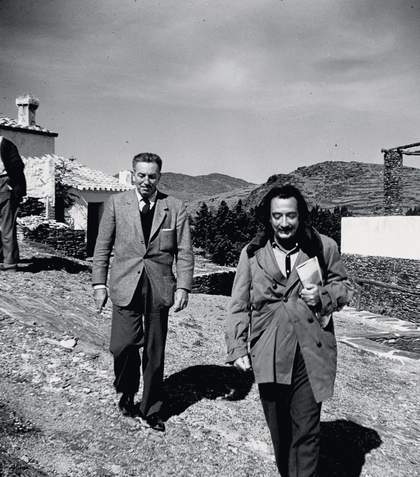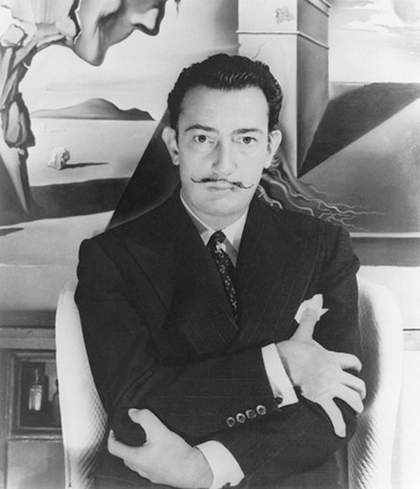Salvador Dalí (1904–1989) is certainly one of the most popular artists in the world today. In his own lifetime, he permitted the dissemination of his work (to say nothing of fakes) in the form of huge editions of lithographs, and you can’t help but think that it was the fate of his pictures to end up as posters in the bedrooms of teenagers – often his keenest audience. This popularity made him, in effect, the first pop star of painting, and it is not by chance that the artist quoted by Marilyn Manson during a recent promotional interview for his own exhibition of watercolours in Paris was Dalí.
On the surface, his painting is filled with nostalgia for a golden age of art, a fascination with the illusionistic and technical virtuosity of the Old Masters. Youthful works such as The Basket of Bread 1926 are done in an ultra classical style reminiscent of Velázquez and Zurbarán. However, there was more to Dalí than being a modern master. His re-use of paintings, such as Millet’s Angelus, revealed an ambivalent interest in religion, as much as it did the desire to recycle popular imagery. And his special form of anti-Modernist provocation that never lessened during his lifetime, as well as his involvement in the culture industry and popular culture, may explain the current revival of interest in his work.
The Surrealist writer André Breton nicknamed him ‘Avida Dollar’– an anagram of his name – on account of his fondness for money. Dalí had no qualms about linking art and money. He no doubt subscribed to the view of that other great personality of twentieth-century art, Andy Warhol, that ‘business is the highest artform’. However, while Dalí represented an unhinged, irrationalist aspect of the avant-garde, Warhol represented its industrial rationalisation – transforming the model of the artist into a ‘director’, press magnate and advertising agent, and turning the traditional studio into a factory.
Part of Dalí’s allure was his visibility. While Warhol insisted that you could see his personality in the surface of his paintings, with Dalí, the question to be asked was: who was behind the public mask of the Grand Guignol showman? Like Warhol, he had an acute sense of the value of publicity and self-promotion. He published a great deal in magazines. He designed the cover of Vogue in 1939, 1944 and 1946, and edited a whole issue in 1971 for the French edition. He also designed covers for Town and Country and American Weekly. In the mid 1940s he decided to launch his own newspaper, Dalí News (a pun on the title of the New York Daily News), which was entirely devoted to the topic of Dalí – the man, his exhibitions, his paintings and his films. The French art critic Pascal Beausse recently used the term ‘self-media’ when referring to how some of today’s artists (for example, Wang Du, Bruno Serralongue and Pierre Huyghe) have utilised mass media such as television and the press to make their art. Dalí was, undoubtedly, the first of these self-media artists.
At a time when Modernism is being subjected to a critical re-evaluation, Dalí now appears as an alternative model. Along with Francis Picabia, with whom he shared a propensity to paint in a range of contrasting styles at the same time, he enjoyed working in the arena of kitsch. And he employed it as a deliberate provocation – an avant-garde attitude directed against the good taste of the nascent high Modernism. In an article published in 1939, entitled ‘Avant-Garde and Kitsch’, the American art critic and champion of Modernism in painting, Clement Greenberg, wrote that ‘Surrealism in plastic art is a reactionary tendency which is attempting to restore “out-side” subject matter’. In the pre-war United States, Dalí embodied the archetype of the Surrealist painter, at least in the eyes of the public and Greenberg, who stated that ‘the chief concern of a painter like Dalí is to represent the processes and concepts of his consciousness, not the process of his medium’. Yet it is precisely because of this ‘concern’ that Dalí has regained a positive aura among artists opposed to Modernist good taste – Peter Saul said: “Dalí used to get the subject matter and the content out in front of the paint, even if he tried to look like a virtuoso in painting’ – and inspired a whole new generation, from Jim Shaw to Glenn Brown, even if they do work in very different styles.
Dalí was also a Pop artist, avant la lettre and before the appearance of Claes Oldenburg’s soft sculptures or Joe Colombo’s sofas. When he was asked to redecorate (with interior decorator Jean Michel Frank) Elsa Schiaparelli’s fashion house in the Place Vendôme, Paris, the result included the Mae West Lips Sofa . Schiaparelli, who dressed Hollywood stars such as Marlene Dietrich and Mae West, regularly involved Dalí. He designed a shoe-hat for her in 1937, and inspired many printed fabrics for her collections. The artist was always much more than an observer in the culture industry. He made printed fabrics for the Martha Mills textile company, designed many advertisements for Bryans Hosiery in the 1940s, produced advertising collages for perfumes and cigarettes and even designed the packaging for Chupa Chups lollipops.
One of Dalí’s most spectacular incursions into the culture industry was certainly his Surrealist fun house, made for the New York World’s Fair in 1939. This was almost 20 years before Richard Hamilton’s ‘pop’ fun house in This is Tomorrow at the Whitechapel Art Gallery in 1956, and almost 60 years before Benjamin Buchloh wrote of the Skulptur Projekt, Münster, in 1997, that it ‘reflect[ed] the production of art as an advanced form of entertainment for an ever-more sophisticated and increasingly bored middle class’. Entitled The Dream of Venus, it attempted to transpose to a mass culture context the kind of environment that had been created in Paris at the Exposition Internationale du Surréalisme in 1938. The ‘delirious and grotesque’ pavilion was in the so-called amusement area of the World’s Fair, where art was explicitly presented as pure spectacle, and housed a sequence of stagings of Venus’s dreams. The installation included some of Dalí’s most emblematic paintings – soft watches, a lobster, giraffes in flames – as well as groups of sculptures and tableaux-vivants that gave life to dreams: mermaids, ‘exquisite corpses’, Surrealist objects and mannequins. His interest in the entertainment spectacle did not stop there. In 1957 he came up with the project for a Surrealist nightclub in a palace in Acapulco (never realised), and when he opened his TeatroMuseo in Figueres, he installed fairground-type penny-in-the-slot machines so that the public could see his own 3D illusionistic displays.
The most important aspect of Dalí’s work was the representation of unconscious psychic life, inspired by psychoanalytic theory. He went about this task in a different way from the automatism practised by Breton, or the way in which painters such as Paul Delvaux depicted the dream world. Dalí’s painting revealed his desire to represent an imaginary world that incorporated photography and film, seeing them as new vehicles of imagery and fantasies that were almost universally shared.
Dalí turned the world of cinema, with its repertory of collective figures and ‘inscapes’, into one of the subjects of his art. Many paintings and collages included fragments of images of Hollywood stars, such as the collage Ginger Rogers with Butterflies and Roses 1940s. The sources of his images were often already familiar in the popular imagination. In Shirley Temple, The Youngest, Most Sacred Monster of the Cinema in her Time 1939, Temple is literally depicted as a monster, a sort of sphinx. And stuck on the bottom section of the canvas is a trompe l’oeil label that reads: ‘Shirley!… at last in Technicolor.’ In this, his paintings and collages echoed the technical innovations of the time: a Technicolor dream (or nightmare), a photographic, filmic unconscious.
Dalí also worked in collaboration with the film industry. Portrait of Laurence Olivier in the Role of Richard III 1955, for example, was commissioned as part of the promotion for Richard III, adapted from Shakespeare’s play. Apart from the two films he made with Luis Buñuel, including Un Chien Andalou 1929–30, which remains the Surrealist film par excellence, Dalí came up with other film projects, such as Babaouo, which did not get beyond the script stage, and designed the set for the dream sequence in Alfred Hitchcock’s Spellbound. Walt Disney employed him in 1946 to help him to produce Destino, an abandoned six-minute animated film on which he spent eight weeks in the studios (and which was finally completed and released last year).
His desire to paint the hidden, inner world was matched by his wish to convey the hidden structure of the universe and the image. Portrait of My Dead Brother 1963 suggests both an inner world and a certain depth to the image, as though the Ben Day dots constitute an atomic structure of the picture. Like molecules or elementary particles, the cherries that at first seem to make up the print texture appear to form an organic grid whose points come together to depict the remembered face of his brother, and also of other figures. This reconsideration of the various components of the image finds new resonance today, when a more general suspicion exists towards the image, or, at least, towards its capacity to offer an absolute truth.



